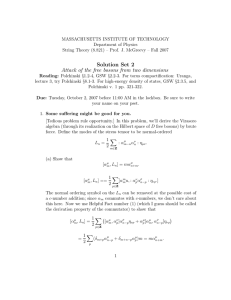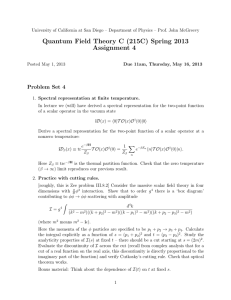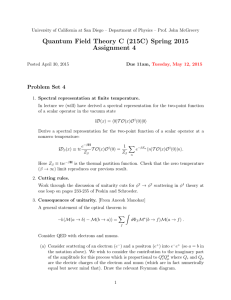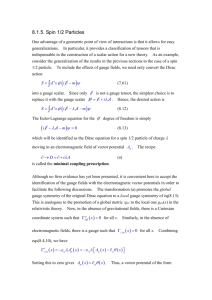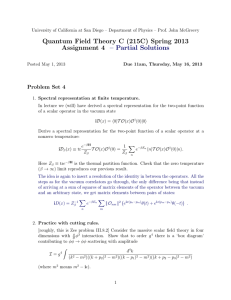MASSACHUSETTS INSTITUTE OF TECHNOLOGY Department of Physics
advertisement
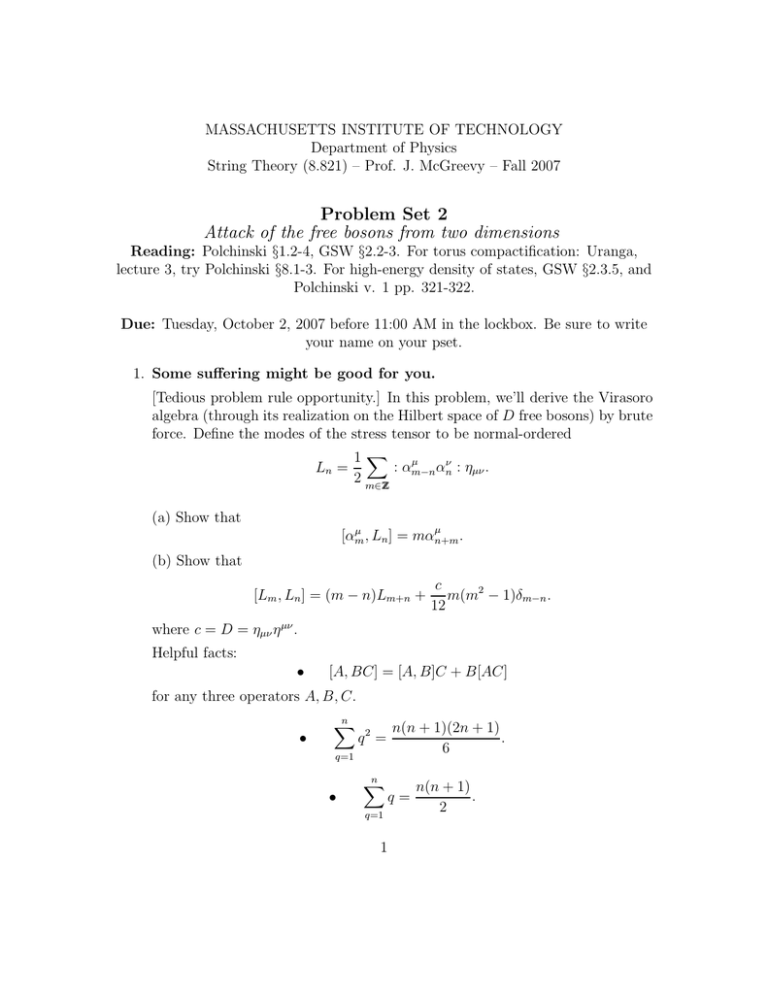
MASSACHUSETTS INSTITUTE OF TECHNOLOGY Department of Physics String Theory (8.821) – Prof. J. McGreevy – Fall 2007 Problem Set 2 Attack of the free bosons from two dimensions Reading: Polchinski §1.2-4, GSW §2.2-3. For torus compactification: Uranga, lecture 3, try Polchinski §8.1-3. For high-energy density of states, GSW §2.3.5, and Polchinski v. 1 pp. 321-322. Due: Tuesday, October 2, 2007 before 11:00 AM in the lockbox. Be sure to write your name on your pset. 1. Some suffering might be good for you. [Tedious problem rule opportunity.] In this problem, we’ll derive the Virasoro algebra (through its realization on the Hilbert space of D free bosons) by brute force. Define the modes of the stress tensor to be normal-ordered 1X µ : αm−n αnν : ηµν . Ln = 2 m∈ZZ (a) Show that µ µ [αm , Ln ] = mαn+m . (b) Show that [Lm , Ln ] = (m − n)Lm+n + c m(m2 − 1)δm−n . 12 where c = D = ηµν η µν . Helpful facts: • [A, BC] = [A, B]C + B[AC] for any three operators A, B, C. • n X n(n + 1)(2n + 1) . 6 q2 = q=1 • n X q= q=1 1 n(n + 1) . 2 Note: If you insist, you could instead find the central charge using the method described in GSW §2.2.2 (and made into an exercise in Becker2 -Schwarz problems 2.13-2.15, p. 57). 2. Virasoro operators really do generate conformal transformations. Recall that fixing conformal gauge in the Polyakov theory leaves a residual gauge invariance: reparametrizations of the form σ ± 7→ σ̃ ± (σ ± ) change the metric in a way that can be compensated by a Weyl gauge transformation, preserving the form of the metric. Such transformations are called conformal transformations. The infinitesimal form of such a transformation is σ̃ ± − σ ± ≡ δσ ± = ξ ± (σ ± ). This is two functions worth of transformations (an infinite-dimensional group), a useful basis for which is Fourier modes: ± imσ . δǫ±m σ ± = ǫ± me Under this transformation, a scalar on the worldsheet transforms as X(σ + , σ − ) 7→ X(σ̃ + , σ̃ − ) = X + δǫ X with X imσ± (⋆) δǫ X = ǫ± ∂± X. me m,± When quantizing the string, after some circuitous logical meanderings, we discovered that we should impose (Lm − δm a)|physi = 0 = (L̃m − δm a)|physi, m>0 on physical states. Using the canonical commutation relations, show that the operators Lm , L̃m indeed generate the transformations (⋆) by commutators, i.e.1 − δǫ X = i[ǫ+ m Lm + ǫm L̃m , X]. Note: If you prefer, do this problem with a euclidean worldsheet, using com+ − plex coordinates on the plane (i.e. replace eiσ with z and eiσ with z̄ ). Only the notation is different. 1 Note that I have forgotten the i in δO = i[Q, O] a number of times in lecture. It had better be there so that the both hand side can be hermitian when O is. 2 3. A simple 2d GR problem. (a) Find the Christoffel symbols Γkij (i, j, k = z, z̄) for the conformal gauge metric ds2 = e2ω(z,z̄) dzdz̄. (b) Show that the covariant expression for the reparametrization FP ghost action Z 1 √ d2 σ γbab ∇a cb Sgh = 2π (here ∇ is the metric-compatible covariant derivative) reduces in conformal gauge to Z 1 Sgh = d2 z (bzz ∂z̄ cz + bz̄ z̄ ∂z cz̄ ) . 2π √ √ [note that γ ≡ − det γ by definition] (c) [bonus] Find the Ricci scalar for the conformal gauge metric. 4. Kaluza-Klein decomposition. (a) Find the (D − 1)-dimensional spectrum of fields (i.e. their masses) that arises by compactifying a single free massive scalar field φ on a circle of radius R, governed by the action Z SD [φ] = − dD x ∂M φ∂ M φ + m2 φ2 (1) where the indices M, N = 0..D − 1; we’ll reserve µ, ν = 0..D − 2 for the noncompact directions. (Note: No gravity yet.) [Hint: expand the field in a basis of single-valued functions on the circle on which the translation operator eip̂y (y ≡ xD−1 ) acts diagonally.] (b) In lecture 4 I claimed that compactifying D-dimensional GR on a circle produced a D − 1-dimensional graviton gµν , a D − 1-dimensional gauge field Aµ , and a scalar field σ (plus all of their massive KK harmonics). Demonstrate that this is the case (to your own satisfaction) starting from the ansatz for the D-dimensional metric ds2 = GM N dxM dxN = e2σ (dy + Aµ dxµ )2 + gµν dxµ dxν . where y ≡ y + 2πR is the coord on the circle. (e.g. you might want to show that the D-dimensional Einstein-Hilbert term Z √ 1 D d x GRD (D) 8πGN 3 produces kinetic terms for g, A, σ.) [Hint: use the gauge invariance Aµ → Aµ + ∂µ ǫy (x) (which is a subgroup of the D-dimensional coordinate invariance) to constrain the possible terms in the Lagrangian.] I claimed further that the charge to which the gauge field coupled was the KK momentum (i.e. the momentum along the circle). As a test of this claim, couple the scalar in part (a) to D-dimensional gravity – i.e. replace (1) with the fancy covariant expression Z √ SD [φ, G] = − dD x G ∇M φ∇N φGM N + m2 φ2 . – and show that this expression includes a minimal coupling between A and any mode of φ which carries momentum along the circle, with strength proportional to the momentum. (c) What is the D−1-dimensional Newton constant in terms of the D-dimensional (D) one, GN ? What is the gauge coupling for the KK gauge field (i.e. the unit of electric charge)? Do the engineering dimensions of all these quantities make sense? (d) [Bonus Q] What do you get if you compactify pure gravity on a space with isometry group G? 5. No Goldstone bosons in two dimensions. [This is really more a diatribe than a problem.] (a) Show that the euclidean 2d massless scalar Green function G2 ∇2 G2 (z, z ′ ) = −2πδ 2 (z − z ′ ) (z = σ1E + iσ2E ) is given by G2 (z, z ′ ) = − ln |z − z ′ |, for example by Fourier transform. (b) The long-distance behavior of G2 has important implications for the physics of massless scalars in two dimensions. Thinking of G2 as the two point function of a massless scalar G2 (z, z ′ ) = hX(z)X(z ′ )i, let’s ask the following question: 4 There is no potential energy for the field X in the Polyakov Lagrangian. A four-dimensional physicist Someone used to physics in (3+1)-dimensions might think that this means that there is a vacuum for every value of X, i.e. that X is a modulus. Let’s try to fix the expectation value of the scalar hXi = x and see what happens. Perturb the (conjectured) vacuum |xi a little bit at the worldsheet position z by inserting the operator X there. To measure what happens, we insert the operator X at z ′ . The correlator G2 can thus be interpreted as a measurement of how the effects of our perturbation fall off with distance. What happens? Contrast this with the behavior you would see for a scalar field with a flat potential in three or more (really 2 + ǫ) dimensions. It may be useful to remind yourself about the (even more dramatically infraredproblematic) case of (0+1) dimensions, i.e. QM. Note, by the way, that the Goldstone-ness of the massless bosons (i.e. whether they are massless because of a symmetry) is not crucial. In non-supersymmetric sigma models, one expects massless bosons whose mass is not protected by a symmetry to be lifted quantumly, but in supersymmetric theories, this need not be the case. So this story is also important for supersymmetric NLSMs where the target space has no continuous isometries, as is the case for Calabi-Yau manifolds. This result is called the Coleman-Mermin-Wagner theorem (sometimes Hohenberg, too). For help, read S. Coleman, “There are no Goldstone bosons in two-dimensions.,” Commun.Math.Phys. 31:259-264 (1973). 6. The guts of the Veneziano amplitude. Consider a collection of D twodimensional free bosons X µ governed by the action Z 1 d2 σ∂a Xµ ∂ a X µ . S=− 4π (a) Rotate eiS to Euclidean space (d2 σ = −i(d2 σ)E ) and compute the Euclidean generating functional Z E D R 2 R 2 µ (d σ)E J µ Xµ −1 [dX]eiS e (d σ)E J Xµ ≡Z Z[J] = e (where Z ≡ Z[J = 0], but please don’t worry too much about the normalization of the path integral.) [Hint: Use Wick’s theorem or do the Gaussian path integral. Use the Green function from the previous problem.] 5 (b) Show that * N Y √ −i 2α′ ki ·X(σ(i) ) :e i=1 + : = N Y i,j=1 ′ |zi − zj |α ki ·kj (i) (i) where σ (i) label points in Euclidean space, zi = σ1 + iσ2 , α′ is the Regge slope, and kiµ are a set of arbitrary D-vectors in the target space. [Note 1: There is an important lie here. To unmask the lie, consider the consequences of the global symmetry X µ → X µ +constµ , particularly in light of the previous problem, and its implications for the invertibility of the laplacian.] relative to our [Note 2: In the last two problems I’ve rescaled Xusual = X√here α′ usual normalization of the free bosons – these X variables are dimensionless in the target space.] 6
